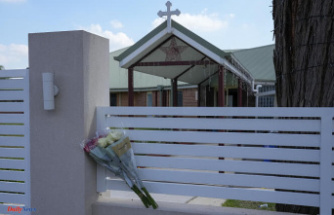It is often only short stretches that have to be completely closed to traffic due to construction work. But the impact on residents can be huge. This is shown by four examples from Hesse.
Wiesbaden (dpa/lhe) - Across Hesse, construction sites are always causing anger and resentment because residents have to put up with long detours or road closures even separate districts from each other. While some cities and residents are suffering from traffic chaos and long detour routes, others are still fighting a full lockdown.
Construction work is expected to separate the residents of large and small rooms near Darmstadt for about two years. Since mid-September, the country road 3155 between the municipality of Groß-Zimmern and its district has been completely closed for the construction of a 660 meter long cycle path and footpath, two bridges and a fish ladder. The detour for motorists set up by the Hessen Mobil road construction authority means around four kilometers of detour. Cyclists and pedestrians can switch to a separate detour - which means an additional 250 meters.
"Unfortunately, the detour has to be accepted. There is no better alternative," said an employee of the Groß-zimmern building authority. "Of course there is resentment, but also understanding and acceptance of the construction work. We expected a bigger outcry." Two bus routes are also affected by the closure, which are being diverted. Passengers and drivers will probably have to adjust to longer travel times until mid-2024.
The residents of Lorch in the Rheingau also expect this. The federal highway 42 between Lorch and Rüdesheim has been closed since the beginning of October. And not for the first time. Road expansion work and the construction of a footpath and cycle path along the Rhine have been underway since the beginning of 2020. This year, the route was already closed between March and July. From the middle to the end of last year there was also an unscheduled full closure because the Rhine flood had washed away the road.
"It annoys everyone here," said Lorch's independent mayor, Iwo Reßler. The economic damage to the companies in his community increases with every day of a full closure. Hessen Mobil has set up a detour of around 21 kilometers for the approximately five-kilometer-long construction site.
"The detour not only costs time, but also money. Especially on the winding route up and down the mountain, I have an additional consumption of 1 to 1.5 liters of petrol per 100 kilometers," said Reßler about the detour through the Taunus. This is an impertinence, especially for trucks and buses. And for cyclists, instead of going along the Rhine, the detour will first go seven kilometers up the mountain.
When asked, a local forwarding agent explained that the detour would result in additional costs in the mid-six-figure range. In addition to the fuel costs, the wear on the brakes and tires on the mountain route also plays a role.
School buses are also affected by the closure near Lorch. An employee of the Rheingau-Taunus-Verkehrsgesellschaft explained that three bus trips would be diverted or shortened. Due to the tight space on the B42 between the Rhine and the railway line, there was no alternative to a full closure, Hessen Mobil said. Between October and probably mid-November, the residents of Lorch will have to live with the new full closure.
This also threatens the inhabitants of the Lorsbach district of Hofheim. According to Hessen Mobil, in order to renew a retaining wall at the local mill ditch that was dilapidated by undermining, the 3011 country road between Lorsbach and Hofheim must be closed for a year. The route is too narrow to allow traffic to bypass the construction site. With the closure, the Taunus district would have been cut off from the center of Hofheim for a long time. A wide-ranging diversion through neighboring towns is planned. Instead of four kilometers to the center of Hofheim, it would be around 16 kilometers on the detour route.
An action alliance is therefore calling for alternatives to the full lockdown. Most of the few shops in town lived mainly from commuters and, like the local craft businesses, their existence would be threatened by a long closure, said a spokesman for the action alliance. In addition, the planned diversion route will cause high additional fuel costs.
"Of course, as a city, we don't welcome the fact that a district is to be cut off from the core city for a year. That's why we have an interest in looking for an alternative," said a spokesman for the city of Hofheim. In mid-October, the municipal transport committee wants to discuss possible options again with Hessen Mobil before the threat of full closure in March 2023.
The federal highway 454 near Schwalmstadt is expected to be completely closed until shortly before Christmas. About 1.6 kilometers of the road is being renovated here in the Schwalm-Eder district. The official diversion route will take place, among other things, through the Schwalmstadt district of Ascherode. "There we see a massive increase in traffic. The approximately 13,000 cars that otherwise drive daily on the B454 now have to go through Ascherode. This is a burden for the residents," said an employee from the regulatory office.
Although there is a more extensive detour for trucks, many would also squeeze through the narrow street in the town center as a faster shortcut. Drivers who are looking for their own shortcuts also cause resentment in the village. An additional traffic light on the detour route should at least provide more safety for pedestrians. Since all three construction phases planned by Hessen Mobil will be completely closed, residents will have to be prepared for two more traffic chaos in the coming year.












